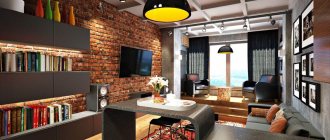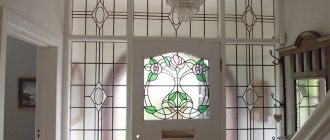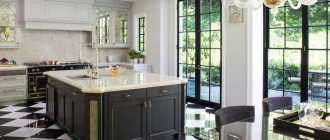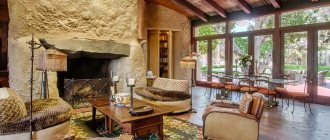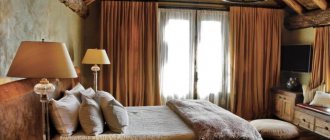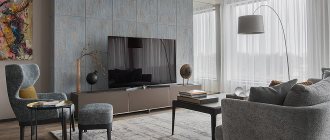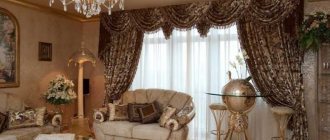Highlights of antique interior design
The era of Ancient Greece and Ancient Rome is famous for its masterpieces of architecture, sculpture, and art. The antique style of interior design is borrowed from the history and culture of these countries.
A little history
Architectural works of antiquity (from 776-476 BC) are role models for masters of later eras. Artists of the ancient world created images that convey the harmony of nature. All the creations of the ancient Greeks and Romans were complete. Compositional construction is an obligatory element of architectural structures, sculptural complexes, and paintings.
The antique style combines the Roman and Greek eras. The Roman style was completely borrowed from Greek culture. Roman and Greek cultures have many similarities, but there are also significant differences. Roman design is more militant, aggressive, with a “taste” of luxury and abundance; Greek elements tend to be closer to nature.
Modern designers do not distinguish between the subtleties of Greek and Roman design and combine them into one concept - antique style.
Modern designers use antique elements to create.
The influence of antiquity did not pass by the Byzantine style, which absorbed many elements of the style of Ancient Greece and Ancient Rome. Byzantine design successfully combines features of antiquity and oriental motifs. In addition to sophistication and sophistication, luxury and pomp characteristic of the East were added.
Characteristic features of the antique style
This style skillfully combines beauty and functionality. The interior elements are beautiful, majestic and practical. The peculiarity of using antique design is that such interior design will not be organic in small areas. Only a spacious room can become a good container for classical antiquity.
In a spacious room it is much easier to embody the basic elements of antiquity
Characteristic features of the antique style in the interior:
- The presence of an arched order cell (triumphal arch).
- Domed ceiling, painted or supplemented with reliefs.
- Decorating walls with frescoes (wall paintings).
- Mosaic floor.
- Decorating the room with floor vases, busts, figurines and majestic statues.
- Use bright colors.
- The use of colonnades and porticoes for room zoning.
- Natural materials (gypsum, wood, natural stone, clay, fabrics).
It should be noted that the grandeur of this style is not associated with an excess of luxury. The richest interiors were decorated with a small number of expensive things. Taste and a sense of proportion always distinguish antique-style interiors, despite the use of gold, inlay, jewelry made of valuable wood, ivory, and precious stones.
Materials for furnishing an antique house
When creating an antique style in the interior, you need to take into account what materials were available more than two thousand years ago.
Naturally, only natural ones: wood, stone, clay, bone and bronze. It is also permissible to use modern ones that imitate them.
For example, it makes no sense to make decorative columns and pilasters from plaster or marble; they can be perfectly replaced by polyurethane or plasterboard.
For design in an antique style, caissons, that is, recesses in the ceiling, are noteworthy. Initially, they performed only a constructive role and arose as a result of the intersection of ceiling beams. But over time, they began to be decorated with marble and terracotta tiles. To decorate them, you can also use various stucco moldings or even resort to artistic painting.
It is enough to paint the walls one color or decorate them with textured plaster.
An important place when decorating a room in an antique style is occupied by stucco: cornices, pilasters, frames and bas-reliefs. These architectural elements remain light and monochromatic (white, ivory or beige).
There is a tendency to decorate them with gold paint, which undoubtedly looks very elegant, but was never seen in ancient houses. After all, the Ancient Greeks used only bronze among metals.
To emphasize the antique style in the interior, the surfaces are painted with frescoes. The most popular are mythological themes: almighty Olympic gods, beautiful goddesses and valiant warriors.
Everyday scenes from the life of the Ancient Greeks are also appropriate. Even simple geometric and floral patterns inherent in ancient culture will add the right touch to the room.
The most used flooring material in Ancient Greece was clay. Only the wealthiest townspeople could afford to have marble floors. Nowadays, it is important to make flooring from tiles with colors reminiscent of natural stone.
Interior decoration in antique style
To make a room in the style of Ancient Greece or Ancient Rome, it is necessary to use the knowledge and skills that the inhabitants of these countries possessed. There are a number of “requirements” that must be met in order to embody the spirit of antiquity in your interior:
- spaciousness and significant footage of premises;
- high ceilings;
- the complexity of the geometric shapes of the rooms, the presence of niches and projections;
- panoramic windows;
- widened openings with double doors.
To recreate the antique style, preliminary preparation is necessary. It is necessary to carefully consider all the interior elements and clearly imagine the layout. The ceiling can be decorated with a painting or painting depicting a military battle, an athletic competition, or a luxurious feast. For the floor, designers use mosaic or marble. The walls are artificially aged and decorated with columns, porticoes, and bas-reliefs. The painting can be located not only on the ceiling, but also on the walls. Glass, crystal, mirror elements in antique design will emphasize the uniqueness of this style. Large mirrors in elegant frames are not uncommon in antique-style rooms. Elegant furniture, the use of upholstery made from natural fabrics, environmentally friendly textiles (linen, teak, satin) characterize the antique style of the premises.
Antique style bedroom
The bedroom is the most secret place
in the house.
Her environment has a definite impact on her personal life, health and well-being. Therefore, the arrangement of intimate space is always treated with special attention and trepidation.
To create an antique interior, use light colors such as cream, yellow, soft blue or pink. The role of the ceiling plinth is played by the bas-relief around the perimeter of the room. The walls are decorated with liquid wallpaper imitating ancient frescoes. The floor is covered with a long-pile light carpet or mosaic. To create an intimate atmosphere, a canopy framed in translucent fabric is installed above the bed. On the sides of the sleeping bed there are small chests that serve as modern bedside tables.
Decorative objects and accessories harmoniously emphasize the antique style - bronze figurines, a mirror in an elegant frame
, busts, panels, ceramic vases. An important condition is the combination of all attributes and accessories used in the interior. A fireplace fits well into a cozy bedroom in antique style. A carpet imitating the skin of an animal is laid out next to it. Sconces stylized as torches are hung on the walls.
Color solution
Antique style consists of natural materials, without additional coloring. Therefore, initially the interior design in the style of antiquity was muted in color.
In spacious apartments it is much easier to embody the basic elements of antiquity
The interior of that time was dominated by shades of white, brown, beige, and black. Sometimes you could find decorations in blue, olive, or terracotta. Designers of our time prefer to use a contrast of two colors in the interior: black and white, beige and brown, light olive and green. To add saturation, masters of design art have to resort to using several shades of the same color. In any case, no loud or bright colors are suitable for creating an antique spirit in the interior.
History of origin
Antiquity refers to the civilization of Ancient Greece and Ancient Rome. Ancient culture served as the primary source of all subsequent Western art. Greco-Roman culture gave the world not only the lion's share of the arts, but also outstanding scientific achievements.
Triumphal Arch
The time frame for the beginning and end of the ancient era differs in different regions. So the peak of the development of ancient culture in Greece came earlier than in Rome. At the same time, ancient civilization in the Eastern part of the Roman Empire arose and died out earlier than in the Western one.
Antiquity is usually divided into the following cultural periods:
- Aegean (3rd-2nd centuries BC);
- Homeric (11th-9th centuries BC);
- archaic (8-7 centuries BC);
- classical (5-4 centuries BC);
- Hellenistic (2nd half of the 4th - mid 1st centuries BC).
Aegean period
During the Aegean period, the emergence of ancient culture took place, which is associated with the existence of the Monoan and Mycenaean civilizations. In Crete, inhabited by the Minoans, the first rudiments of statehood and writing began to develop much earlier than in mainland Greece.
In the 12th century BC. Greece is captured by the Dorians, and the Mycenaean civilization ceases to exist.
Homeric period
During the Homeric period, the final liquidation of the Minoan and Mycenaean cultures took place. The society is dominated by tribal relations, gradually transforming into class relations, and the first cities begin to emerge.
Neoclassical School of Art in Athens, Greece
Archaic period
The archaic period is considered to be the beginning of the ancient era. At this time, active urban development and great Greek colonization took place. The first Olympic Games are held.
Classical period
The classical era was the heyday of polis Greek society. It accounts for unprecedented economic and cultural progress.
Parferon
Hellenistic period
The Hellenistic period that replaced it coincided with the establishment of the world power of Alexander the Great. Later, after the capture of Greece and Persia by the Romans, ancient culture continued to develop within the framework of the Roman Empire.
Decoration of ceiling, floor and walls
Compliance with the style largely depends on what materials and colors were used in the finishing of the load-bearing elements.
Ceiling
The entire ceiling can be divided into rectangles or squares. For this purpose, wooden beams with beautiful carvings (caisson structure) are used. The ceilings are decorated with stucco, bas-reliefs, and decorative plaster. The sections are painted or painted in accordance with the chosen color scheme.
You can create such a ceiling using modern materials.
Modern materials make it possible to imitate antique ceiling designs. For this purpose, multi-level tension fabrics are used. They are decorated with polyurethane decor in the form of stucco molding and rosettes. Photo printing on a stretch ceiling will look original, reproducing the beauty of the sky. If you skillfully bring lighting to such a ceiling, the interior will become unusual and memorable.
Floor
The use of natural stone and clay is not always affordable for home owners; these materials can be replaced with more modern and cheaper ones. For example, wooden parquet, natural marble or stone tiles.
Imitation of natural materials or their use are necessary points in creating an antique design
Walls
Increasingly, instead of natural stone, decorative plaster of various shades is used on the walls.
Soft, muted tones will help embody the style of antiquity
It is acceptable to paint on the walls or use frescoes, stucco moldings, bas-reliefs, and borders. The frescoes testify to the campaigns of ancient heroes, battles, illustrate myths or repeat the beauty of nature.
Frescoes are the most common embodiment of antiquity on walls
It is difficult to imagine the antique style without columns and pilasters. If space is required to place columns, then pilasters will fit perfectly into small modern interiors. Vertical ledges will help create the spirit of antiquity without taking up much space.
Interior in antique style: atrium in a modern house
If there is such an opportunity, you can create some kind of ancient Roman atrium in a house or even an apartment. The atrium is an internal light courtyard from which one could access all rooms of the house.
The role of the atrium in a modern house or apartment can be given to the living room, large hall or dining room. To create a semblance of an atrium, you can design the ceiling so that it resembles a compluvium (a hole in the roof above the atrium). You can imitate such a roof by installing a suspended ceiling with a pseudo-window to the sky. There can be columns along the perimeter of the atrium - from 4 to 16. Columns in a modern “apartment atrium” can be plaster or polyurethane - the latter option, of course, is preferable because of its lightness. In the atriums of ancient Roman houses, under a skylight (hole) in the roof, there was a pool into which rainwater flowed. In an apartment, you can imitate this integral detail of an antique house - by laying out, for example, a small island on the floor under a ceiling pseudo-window with white, gray or blue tiles.
Furniture
Luxury, wealth or a good imitation of them - this is what characterizes antique style furniture. At the same time, items should be practical and simple. As a rule, furniture is made of valuable wood and inlaid with gold elements. A round table on one leg or a rectangular creation on three/four “supports” surrounded by chairs, armchairs, benches is typical of the antique style. If designers want to accurately reproduce the furniture of those times, then you can find craftsmen who will build real klismos and kline.
Kline and klismos in the interior will emphasize the commitment to antiquity
In the first case, this is furniture of low design with the following elements:
- round back;
- widely spaced curved legs;
- footrest.
Kline is a kind of synthesis of a bed, sofa and klismos. It is interesting that such furniture was used not only for relaxation, but also for eating in a reclining position. The shapes of all furniture items are streamlined and soft. Sharp corners or complex geometric designs will look inorganic in an antique interior. You can find suitable furniture from antique dealers. If this is not possible, you can try to artificially age modern interior items.
Antique style: furniture
Furniture, of course, should be predominantly wooden. Looks like antique style furniture
expensive. Sometimes even very expensive. But this may just be an imitation of high prices.
Real antique furniture was decorated with carvings, as well as inlays - gold, ivory, wood of a different color. Today, creating an interior in an antique style
, you can furnish the premises with antique furniture with obvious traces of time. However, furniture can also be the result of the work of modern craftsmen. Artificial aging will give the furniture a little antique chic.
The legs of furniture (cabinets, tables, chairs and benches) in the antique style are curved, often in the shape of animal paws or griffin figures. Definitely worth including in an antique interior
famous Greek chairs - klismos.
The upholstered furniture that is now placed in antique interiors is truly luxurious: “lace” frames - wooden with gilding or bronze, puffs, expensive upholstery, streamlined shapes. Although this is rather a greeting from Baroque and Rococo, based, however, on the aesthetics of antiquity.
Lighting
Panoramic windows are a characteristic feature of the antique style. Large window openings, however, are not able to perform the function of lighting the room to the extent needed in the evening and at night. Therefore, designers provide for the inclusion of many devices in the lighting system: lamps, floor lamps, sconces, chandeliers. It is desirable that the light emanating from these devices in the evening be diffused and soft.
Lamps in the form of candelabra are appropriate in antique design
Artificial fireplaces imitating ancient Greek hearths, wall lamps in the form of torches, candelabra and candles are excellent options for additional lighting of rooms. The main emphasis should still be on the chandelier suspended in the center of the ceiling. The material suitable for the chandelier is bronze or crystal.
A stylized lamp will create an atmosphere of antiquity in the interior
In our time, it is also acceptable to use hidden modern light sources - backlights, spotlights.
Accessories, textiles, lighting
Considering that the main lighting of the antique house came through the open atrium, and the additional light sources were torches and the hearth, the lamps in the modern interior are selected accordingly. Hidden lighting and lamps built into the ceiling and niches are suitable for this. Sconces in the form of torches and candelabra are hung on the walls. Classic bronze or crystal chandeliers are hung in the center of the room.
The antique-style interior is decorated with sculptures and ceramic vases of various sizes: from large floor vases to miniature decorative ones. Paintings and tapestries are hung on the walls.
Textiles are represented by luxurious linens made of flax, hemp, and wool. They are used to decorate boxes, beds, windows, and doorways. The ceiling or walls are also covered with fabrics to give them brightness.
Accents of antique style in modern design
A modern interior in the spirit of antiquity can be emphasized by focusing on the characteristic elements of this style:
- columns and pilasters;
- aged furniture;
- frescoes of antique themes;
- decorative elements.
Floor vases, chests analogous to furniture from antiquity, busts of famous people of that era - all this will make the interior stylish and similar to the homes of the ancient Romans and Greeks.
Interior decoration accepts the use of several or one floor vase of the chosen style
Decorative elements used in antique style:
- Plant or floral imitations - leaves, flowers, stems in the form of intricate designs, inlays or carvings.
- Geometric images (spirals, meanders).
- Mythical characters in the form of sphinxes, mystical lions, unprecedented birds and animals.
- Images of battles (on ceilings, walls, on frescoes).
If the dimensions of the room allow, then majestic statues must be placed in the interior of the antique style; in the case of decorating small rooms, you can use busts depicting famous figures of that era.
The premises for such statues should be quite spacious
Textiles should be rich and natural (linen, hemp, wool). Furniture upholstery and curtains do not tolerate synthetic materials. It is advisable to use a lot of folds and draperies in curtains. Luxurious curtains decorate not only window openings, but also walls; fabrics can also be seen on the ceiling.
When using decorative elements, it is necessary to observe the measure so that the design of the room does not go beyond the chosen style.
Video: examples of antique style in the interior
Furnishings
Externally, antique furniture is distinguished by proportionality and uncomplicated lines. Furniture was often created from natural wood or bronze.
The tables were equipped with one, three, four legs, and also had a rectangular or oval shape. The legs of chairs and tables also had different shapes:
- curved;
- flat;
- in the shape of animal paws;
- tapering, as well as connecting the lower part.
The antique style included the use of chairs with long, maximally even backs, benches with original handles, or banquettes with an exclusive back.
Previously, there were no cabinet designs in the modern sense. Therefore, chests made from wood were used to store various things.
The antique interior space was distinguished by minimalist furnishings; it was for this reason that the furnishings were minimal - in the room, attention was concentrated on the free space.
The antique-style furniture was distinguished by chic decor. All details were thought out carefully - the edges of the furniture were decorated with gilding.
Antique style in the design of different rooms
Premises for various functional purposes are decorated in antique style.
Living room
There is a huge scope for antique design in this room. It is good if the room being designed is large, with high ceilings. In such an interior you can place frescoes and tapestries without being constrained in size. Large-scale panels will create the atmosphere of the times of the ancient Greeks and Romans.
A modern embodiment of antiquity in the living room interior
The niches house statues of great figures of Ancient Rome and Ancient Greece. The presence of large floor vases will enliven the atmosphere in the living room and help emphasize antiquity. A lamp in the form of a torch looks organic on the walls of the living room; it’s even better if there are sconces in the form of candelabra. When the floor is made of expensive wood or stone, then you should not hide it under carpets, but if modern materials were used for the floor, then it is best to hide them under a beautiful and rich carpet with appropriate patterns. The furniture in the living room should not only be luxurious and rich (made of natural wood with leather upholstery), but also comfortable, because this room is intended for receiving guests and conducting small talk.
Bedroom
You should not install massive columns or sculptures in the interior of the bedroom, even if the room conditions allow this. Rest at night will not be very comfortable surrounded by majestic objects. You can do it much simpler by using only one main item of this style in the bedroom - the bed. A beautiful patterned back, carved decorative elements, and fabric upholstery are the main features of an antique bed in a modern interior.
The main role in the setting is given to the bed with a beautiful headboard
An excellent design solution would be to place the bed in a niche. You can use a built-in alcove, or you can create an artificial recess in the wall yourself. Wallpaper with gilding on the walls is acceptable in a modern antique-style bedroom. Preference in lighting should be given to soft and diffused light coming from lamps in the form of candelabra or candles. Lighting fixtures are located on both sides of the head of the bed. Lots of soft and comfortable textile pillows, beautiful thick curtains will complement the antique design of the bedroom. The main thing is to maintain the color scheme of the entire room without going beyond the style.
Hallway
The central element of the hallway is a mirror. For an antique design, you need to find a mirror in a gilded frame, and place lighting fixtures on either side of it that imitate lit candles or torches. To fully illuminate the hallway, modern methods are also used - fluorescent lamps on the ceiling, decorated with an ornamented portico. Imitation or use of natural stone and marble on the walls will be quite suitable in style to antique design. If it is not possible to use expensive natural materials, you can use Venetian plaster. The floor can be laid with ceramic tiles, plain or with a pattern.
This is what a modern embodiment of an antique style might look like in a hallway
For furniture in the hallway, it is enough to place a low stool on curved legs with gilding or inlay and a chest with decorative carvings. It is advisable to decorate the entrance opening with columns; the use of an arched vault is also permitted.
Bathroom
To embody antiquity in the bathroom, you will need to install a beautiful bathtub on decorative curved legs. If the room allows, then this item can be placed in the center; in this case, a round-shaped bathroom looks great. The bathtub and washbasin can be placed on a kind of pedestal.
Modern plumbing coexists with antique elements
For furniture, a chair with a high back and a fabric ottoman for the feet will be useful. Antique style in the bathroom is incomplete without a massive large mirror with an elegant frame. You can put stylized ceramic tiles on the floor. An image of mythical characters, laid out using modern materials (ceramic granite, tiles), is appropriate on the wall. Color preferences for decorating a bathroom in an antique style are white combined with gold.
Kitchen
The room for preparing and consuming food can also be decorated taking into account the design of ancient times. Beige, olive, and white colors are suitable for introducing an antique style kitchen. The main thing is to try to keep all design elements in the same color. Beautiful crystal chandeliers with modern lamps will not only illuminate the entire kitchen well, but will also help recreate the spirit of antiquity.
The furnishings of the kitchen room are completely designed in the style of antiquity
A large amount of stucco molding and bas-reliefs can be used on the ceiling and walls of the kitchen. Similar elements are added to the facades of kitchen units. It is advisable to implement a coffered ceiling in kitchens with high ceilings, otherwise this design will stand out from the overall style solution and visually reduce the parameters of the kitchen. The floor in the kitchen is designed in contrasting colors to the rest of the decor. An excellent option is a combination of beige and dark brown shades. A mosaic floor covering will not spoil the appearance of an antique-style kitchen. Ceramic tiles imitating marble or natural stone should be placed in the work apron area.
Photo gallery: antique style in modern times
Antique style in the bathroom looks sophisticated and stylish
The grandeur and beauty of the setting do not exclude convenience and functionality
The contrast of colors in the interior looks original
The entrance hall, kitchen, dining room are combined and designed in the spirit of antiquity
Statues are an invariable attribute of ancient design
Antique style in a modern interior will add majesty to the room. The implementation of this design is most suitable for large apartments. You should not oversaturate such an environment with unnecessary decor, because the style solution of antiquity is self-sufficient and beautiful.
- Author: Iya
Rate this article:
- 5
- 4
- 3
- 2
- 1
(0 votes, average: 0 out of 5)
Share with your friends!
Antique style in the interior: materials, finishing
The living room, bedroom, hall and even the kitchen can be decorated with fresco painting. The subject of the painting can be natural, historical (antique), architectural or based on ancient myths. The fresco may also depict a hunting or war scene. The remaining surfaces of the walls can be painted with matte paint or decorative plaster can be used.
For a formal room (living room, hall), it is worth ordering a coffered ceiling with painting, gilding and other decor.
. It was precisely these ceilings that were characteristic of many ancient architectural objects.
Coffered ceiling
it is created from intersecting ceiling beams, but not rough, but graceful, between which there are recesses (niches). These recesses are decorated with paintings, rosettes and other decorations.
The ceiling can also be matte stretched (possibly with a print) or painted. However, the ceiling can simply be painted and decorated with ceiling rosettes made of plaster or polyurethane. In general, there can be an abundance of stucco in an antique interior: make decorative panels from moldings on the wall, place lampshades and other stucco elements in them. Stucco decorations and columns should not be brightly colored - as a rule, they are plain white, beige, light gray or ivory. If desired, stucco molding can be decorated with gold leaf with an antique effect. Warm-colored tiles with decorative inserts are asking for flooring. The living rooms will come in handy with inlaid parquet. In some rooms you can also install laminate flooring by covering it with carpet. Interior doors can be artificially aged. Let the bathtub, toilet and sinks imitate marble or other stone, and the plumbing fixtures imitate gold. When choosing materials, always keep three epithets in mind: majesty, monumentality, pomp.
